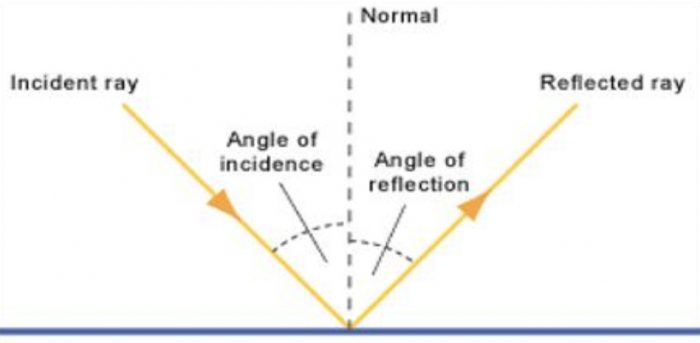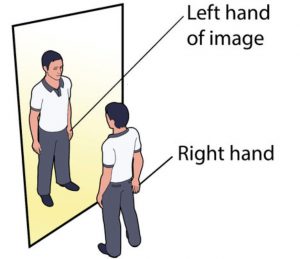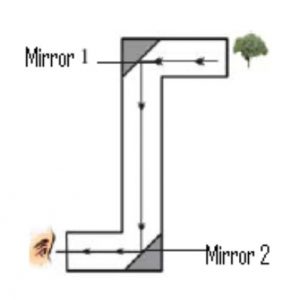Question 1 What is meant by reflection of light?
Question 2 Define the term incident rays and reflected ray?
Question 3 What is a mirror?
Question 4 State the difference between real images and virtual images?
Question 5 What is a periscope?
Question 6 Explain the working and construction of periscope?
Question 7 List few uses of periscope?
Question 8 Why we often see bright circular patches of light on the ground under a tree on a sunny day?
Question 9 What type of object reflects more light?
Question 10 How does the reflection of light from a mirror differ from the reflection of light from a piece of white paper?
Question 11 State the characteristics of image formed in a plane mirror?
Question 12 What is lateral inversion?
Also Read NCERT Solutions for Chapter 11 Light and Shadow
Contents
Reflection of Light
The process of sending back light rays which fall on the surface of an object, is called reflection of light. When a ray of light falls on a mirror at point, it is sent back by the mirror in another direction.
Most of the objects reflect light which falls on them. Some objects reflect more light whereas other objects reflect less light.
The objects having polished, shining surfaces reflect more light than objects having unpolished, dull surfaces.
A shining silvered mirror reflects back almost all the light which falls on it. A table or chair having the surfaces reflect back only a small amount of light which falls on them.
A black surface reflects almost no light.
Ray
A narrow beam of light is called a ray.
A ray of light is represented by a straight line with an arrow head on it. The direction of this arrow shows the direction in which the light is traveling at that time.
The narrow beam of light before reflection is called incident ray and after reflection is called reflected ray. The light hitting the mirror is called the incident ray whereas the light leaving the mirror is called the reflected ray.
Mirror
A shiny surface reduces the absorption of light and causes the maximum reflection of light. An object which reflects light well is called a mirror. A highly polished and shiny metal object reflects light well and act as a mirror.
Silver metal is one of the best reflector of light. Silver metal is used to make the glass mirrors which we use in our everyday life.
The mirror which we use everyday are plane mirrors.
A plane mirror is a thin, flat and smooth sheet of glass having a shiny coating of silver metal on one side.
The glass sheet of plane mirror offers a smooth surface. This smooth surface produces regular reflections and helps in forming a clear image.
The silver metal coating makes the plane mirror shiny. The shiny surface of plane mirror gives us the maximum reflection of light. This helps in forming a bright image.
The red paint behind the Silvered surface of plane mirrors reduces the transmission of light through the mirror and also protects the delicate silver coating of the mirror.
The reflection of light in a plane mirror takes place at the silvered surface inside it.
A mirror reflects most of the light falling on it.
Reflection of light in a plane mirror differs from reflection of light from other objects
The way light is reflected from a surface depends on whether the surface is rough or smooth.
Irregular Reflection
Most of the objects have rough surfaces. Due to the rough surfaces, most of the objects reflect light in all direction. This is called irregular reflection. A piece of white paper reflects the light falling on it in all direction. It is due to irregular reflection of light produced by the rough surface of a piece of white paper that we cannot see the image of our face on looking into the piece of paper.
Regular Reflection
A mirror has a smooth and shiny surface. A mirror reflects all the light falling on it in the same direction. A mirror reflects a ray of light at the same angle at which it strikes the mirror. This is called regular reflection.
Regular reflection produces reflected light in the same arrangement as the incident light ray. The regular reflection of light by the smooth surface of a plane mirror produces an image of our face when will look into the mirror. All the smooth and shiny surfaces reflects light in a regular way forming images.
Some of the common objects having very smooth surfaces are mirrors, polished metal objects and still water surfaces.
Light rays coming from an object and striking a smooth surface are reflected in a regular way. When this reflected light rays enter our eyes, we can see an image of the object in the smooth surface.
If we place a candle in front of a plane mirror, then the smooth and shining mirror surface produces a regular reflection of light coming from the candle due to which we can see an image of the candle in the mirror. The smooth surface of still water in a lake causes regular reflection of light and produces image of various objects like trees, buildings in water.
Image of an object
There are two types of images that can be formed with light :
(1) Real image
(2) Virtual image
Real Image
The image which can be obtained on a screen is called a real image.
For example: The image formed on a cinema screen.
The image formed in a pinhole camera.
A real image is formed when light rays coming from an object actually meet at a point after reflection from the mirror.
A real image can be formed on a screen because the light rays actually passes through it. Real images can be formed by a curved mirror known as concave mirror.
Virtual Images
The images which cannot be obtained on a screen is called a virtual image.
The image of our body formed by a plane mirror cannot be received on a screen, it can be seen only by looking into the mirror.
If we put a screen behind the plane mirror, we will not see anything on it. There are no light rays behind the mirror. The image are not really there at all. Virtual images are also called unreal images.
A virtual image is formed when light rays coming from an object appears to meet after reflection from the mirror. It is not possible to obtain a virtual image on screen because light rays actually do not pass through it.
Highly polished metal objects also form virtual images. We see the reflections of trees, buildings and other objects in the still water of a lake or pond. These reflections of objects in water are virtual images. A type of curved mirror known as convex mirror also forms only virtual image.
Concave mirror can form a virtual image only when the object is very close to it.
Virtual image of ourselves which we see when we look into the plane mirror is the same side up as we are, the images is of same size and images of same distance behind the mirror as we are in front of it if.
If we stand in front of a big plane mirror, we see the image of our body in it. If we lift our right hand, then our image lift its left hand. And if we lift our left hand, then the image appears to lift its right hand. This means that right side of a body becomes the left side in the image, whereas the left side of our body becomes right side in the image. It appears as if our image has been reversed sideways with respect to our body.This effect of reversing the sides of an object and its image is called lateral inversion.
Characteristics of image formed by a plane mirror
(1) The image formed in a plane mirror is virtual or unreal. It cannot be obtained on a screen.
(2) The image formed in a plane mirror is at the same distance behind the mirror as the object is in front of it.
(3) The image in a plane mirror is of the same size as the object. It is neither enlarged not diminished.
(4) The image in a plane mirror is erect. It is the same side up as the object.
(5) The image in a plane mirror is laterally inverted or sideways reversed with respect to the object.
Uses of plane mirror
(1) Plane mirror are used at home to view ourselves.
(2) Plane mirror are used in making periscopes.
(3) Plane mirror are fixed on the walls of certain shops to make the shop look bigger.
Periscope
Periscope is a device which gives us higher view than normal.
Uses of Periscope
(1) By using a periscope we can see the objects on the other side of a high wall, without having to climb over the wall.
(2) We can see over the heads of crowd.
(3) A soldier sitting in a trench can observe the enemy activities above the ground by using a Periscope.
(4) A person sitting in a submarine can see ships over the surface of the sea even though the submarine itself may be submerged under water.
Construction and working of a Periscope
(1) A Periscope consists of a long tube having two plane mirrors fitted at its two ends.
(2) The two plane mirrors are arranged in such a way that they are parallel to one another.
(3) Each plane mirror, makes an angle of 45° with the side of the tube. There are two holes in the Periscope tube, one hole is in the front of the top mirror and other hole is in the front of bottom mirror.
A periscope works on the reflection of light from two plane mirrors arranged parallel to one another.
The upper hole of Periscope is turned towards the object to be seen so that upper mirror faces the object. And we look into the periscope from the bottom hole in front of lower mirror .The light rays coming from the object falls on the plane mirror. The mirror reflects these rays of light towards the lower mirror. The lower mirror then reflects the light towards the eye of the person looking into Periscope through the lower hole. since the light rays coming from the object enters the eye, it is possible to see the image of object in the lower mirror.
| Notes for Chapter 11 Light, Shadows and Reflections |





Leave a Reply